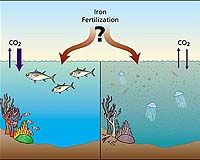| . |  |
. |
Canberra, Australia (SPX) Mar 17, 2010 Australian and US scientists have discovered how changes in winds blowing on the Southern Ocean drive variations in the depth of the surface layer of sea water responsible for regulating exchanges of heat and carbon dioxide between the ocean and the atmosphere. The researchers' findings - published on-line in Nature Geoscience - provide new insights into natural processes which have a major influence on the rate of climate change. The surface-mixed layer is a crucial pathway between the atmosphere and the deeper layers of the ocean. Changes in the depth of the mixed layer can affect air-sea exchange, carbon and heat storage in the ocean, and the rate at which water sinks from the surface ocean into the deep ocean. Changes in the mixed layer also affect biological productivity, by altering how much light and nutrients are available to support growth of plankton at the base of the food chain. The paper's lead author, CSIRO Wealth from Oceans Flagship oceanographer Dr Jean-Baptiste Sallee, said the winds over the Southern Ocean had increased in strength and shifted closer to Antarctica in recent decades. "The shift in winds is one of the strongest trends in southern hemisphere climate over the last 30 years," Dr Sallee said. "The key question is; 'How does the wind change affect the ocean?' "Our knowledge of how the Southern Ocean changes in time is poor because of the lack of ship-based observations in this remote region. But we now have seven years of year-round observations from a fleet of profiling floats known as Argo, which allow us to see for the first time how the Southern Ocean changes with the seasons and from year-to-year." The researchers, including Dr Steve Rintoul from the Antarctic Climate and Ecosystems CRC and CSIRO and Professor Kevin Speer from Florida State University, examined the relationship between changes in wind and changes in the surface-mixed layer. "We found that the depth of the mixed layer was more sensitive than we expected to a wind pattern known as the Southern Annular Mode, the major mode of variability of the southern hemisphere atmosphere," Dr Sallee said. "Even more surprising was the fact that the response is very different in different regions." When the winds strengthen and contract closer to Antarctica, the surface-mixed layer deepens in the eastern Indian and central Pacific oceans, and shallows in the western part of these basins. The reverse is seen when the winds weaken and migrate north. The asymmetry can be explained by small deviations in the generally west-to-east winds and their effect on the heat exchange between ocean and atmosphere: when cold winds blow from the south, this causes heat loss from the ocean and deeper mixed layers. "These changes in mixed layer depth affect how much light is available to support the growth of phytoplankton. We found that changes in the mixed layer depth driven by the winds are associated with changes in the amount of phytoplankton biomass," Dr Sallee said.
Share This Article With Planet Earth
Related Links CSIRO Wealth from Oceans Flagship Water News - Science, Technology and Politics
 Adding iron to sea boosts deadly neurotoxin: study
Adding iron to sea boosts deadly neurotoxin: studyWashington (AFP) March 15, 2010 Adding iron to the world's oceans to capture carbon and fight global warming could do more harm than good, as the mineral appears to boost the growth of a plankton that produces a deadly neurotoxin, a study published Monday shows. Researchers led by Charles Trick of the University of Western Ontario in Canada found that fertilizing the ocean with iron can boost the growth of Pseudo-nitzschia ... read more |
|
| The content herein, unless otherwise known to be public domain, are Copyright 1995-2010 - SpaceDaily. AFP and UPI Wire Stories are copyright Agence France-Presse and United Press International. ESA Portal Reports are copyright European Space Agency. All NASA sourced material is public domain. Additional copyrights may apply in whole or part to other bona fide parties. Advertising does not imply endorsement,agreement or approval of any opinions, statements or information provided by SpaceDaily on any Web page published or hosted by SpaceDaily. Privacy Statement |